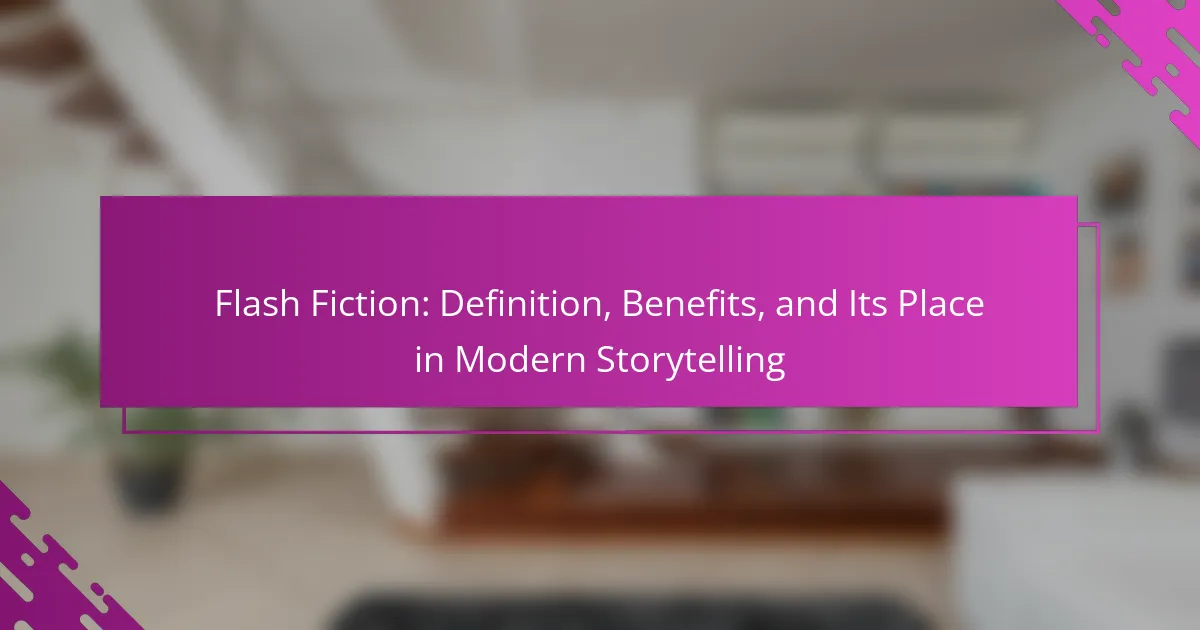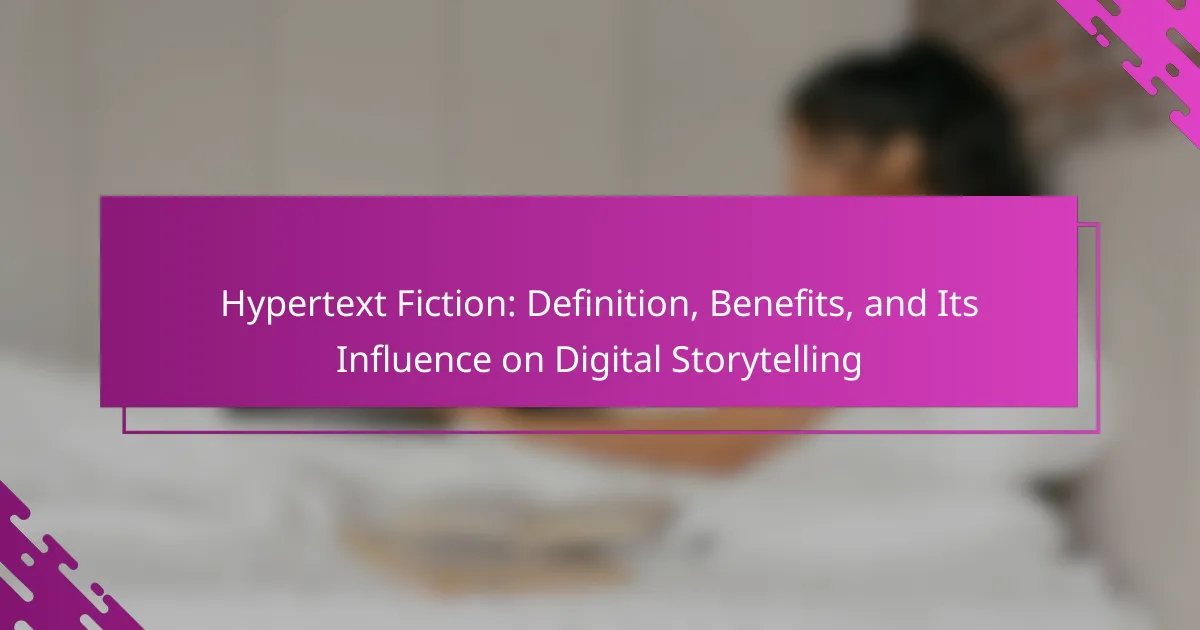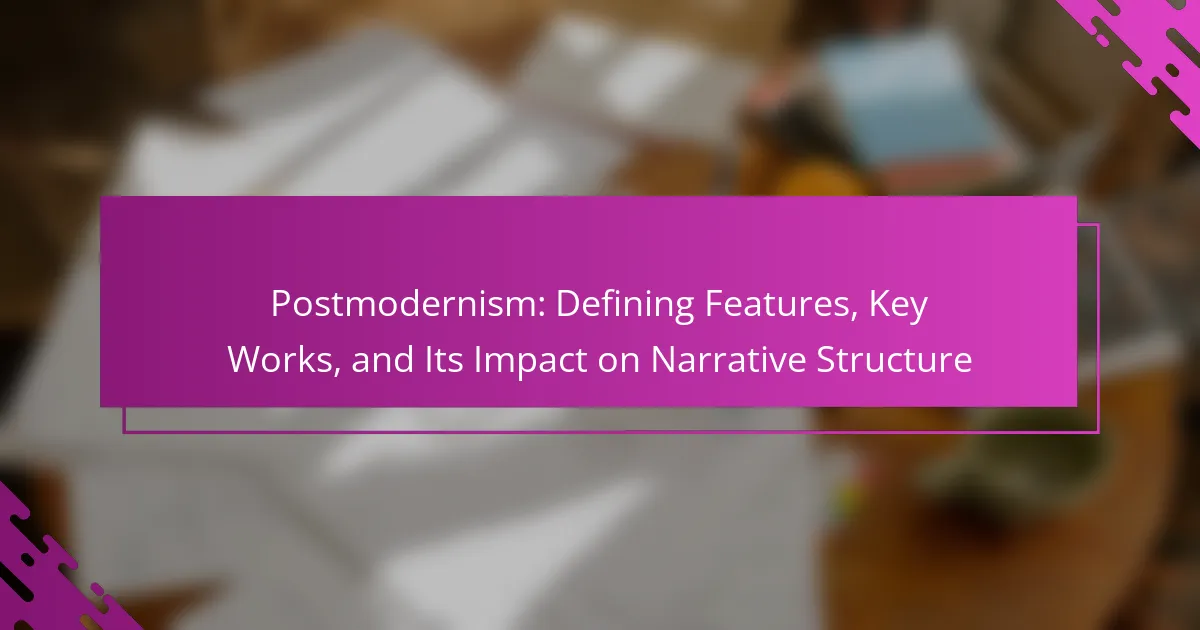Nonlinear narratives enhance reader engagement by encouraging active participation and emotional investment. This article explores their key characteristics, notable examples across various media, and the impact on reader interaction. It also addresses the challenges writers face and emerging trends in nonlinear storytelling design.
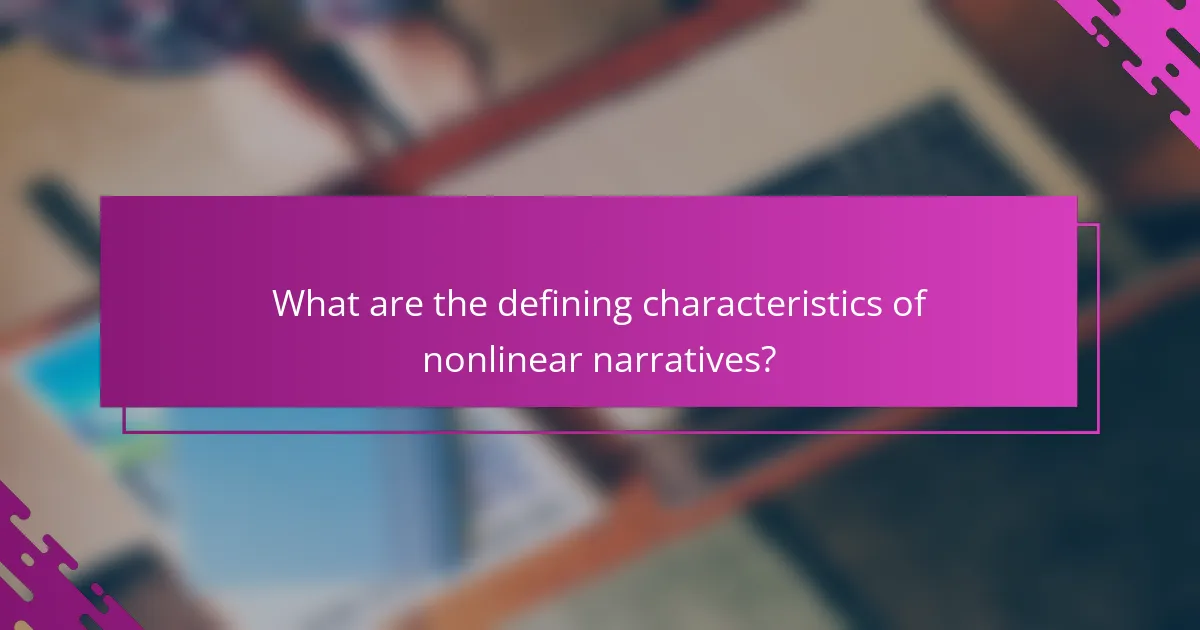
What are the defining characteristics of nonlinear narratives?
Nonlinear narratives are defined by their non-sequential structure, allowing events to unfold out of chronological order. Key characteristics include fragmented timelines, multiple perspectives, and an emphasis on character development over plot. These elements create a complex reading experience that encourages active engagement and interpretation from the reader. Examples include works like “Catch-22” and “The Sound and the Fury,” which challenge traditional storytelling methods. Nonlinear narratives enhance reader engagement by fostering deeper emotional connections and inviting personal reflection.
How do nonlinear narratives differ from traditional storytelling?
Nonlinear narratives differ from traditional storytelling by presenting events out of chronological order. This structure engages readers by allowing them to piece together the story, creating a more active reading experience. Traditional storytelling typically follows a linear progression, making nonlinear approaches unique in their ability to enhance suspense and deepen character exploration. Examples include novels like “Catch-22” and films like “Pulp Fiction,” which challenge conventional narrative flow. These techniques can lead to greater emotional investment and a more personalized interpretation of the story.
What role does structure play in nonlinear narratives?
Structure in nonlinear narratives creates a unique reading experience, enhancing engagement through fragmented timelines. It allows for multiple perspectives, encouraging deeper emotional connections. By challenging traditional storytelling, it fosters active participation, prompting readers to piece together the narrative. This complexity can lead to increased retention and satisfaction as readers explore the intricacies of the plot.
Which narrative techniques are commonly used in nonlinear storytelling?
Nonlinear storytelling often employs techniques like fragmented timelines, multiple perspectives, and unreliable narrators. These methods engage readers by challenging their understanding and encouraging active participation in piecing together the narrative. Other common techniques include flashbacks, parallel storylines, and non-chronological sequences, all of which create a dynamic reading experience.
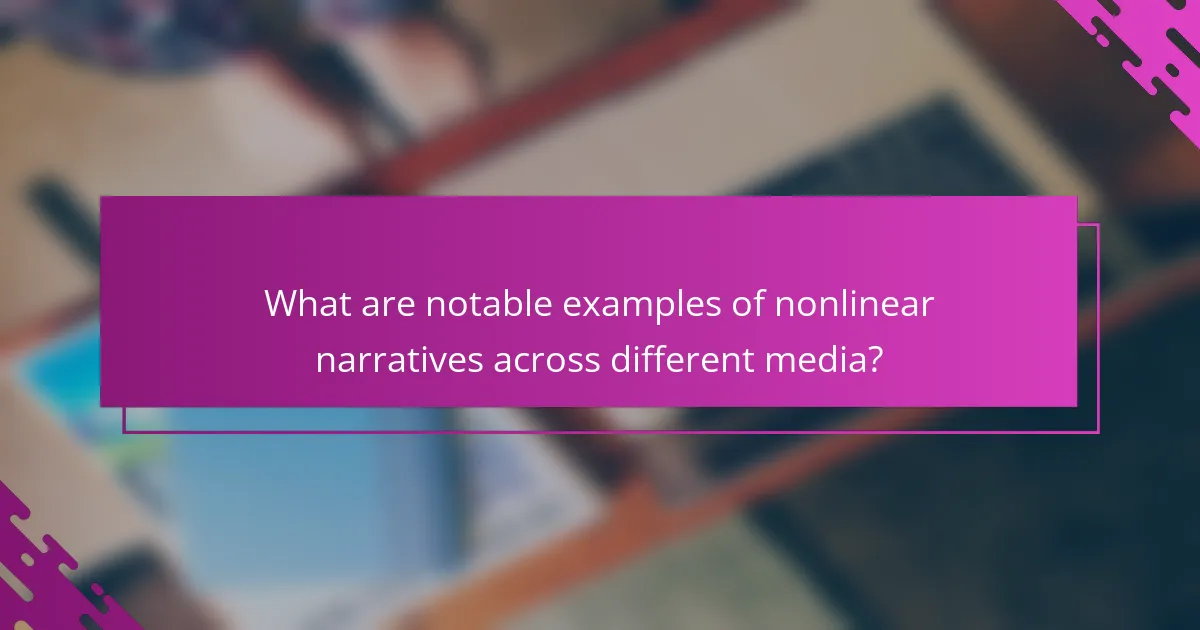
What are notable examples of nonlinear narratives across different media?
Notable examples of nonlinear narratives span various media, enhancing engagement through unique storytelling. In literature, “Catch-22” by Joseph Heller features a disjointed timeline, while “House of Leaves” by Mark Z. Danielewski employs multiple layers of narrative. In film, “Pulp Fiction” by Quentin Tarantino showcases interwoven storylines, and “Eternal Sunshine of the Spotless Mind” explores memories in a non-linear fashion. Video games like “The Legend of Zelda: Ocarina of Time” use time travel mechanics to create a nonlinear experience. These examples illustrate how nonlinear narratives can captivate audiences by challenging traditional storytelling structures.
How have films utilized nonlinear narratives effectively?
Films have effectively utilized nonlinear narratives to enhance storytelling and engage audiences. By presenting events out of chronological order, filmmakers create suspense and encourage viewers to piece together the plot. This technique deepens emotional resonance, as seen in films like “Pulp Fiction,” where fragmented timelines reveal character motivations and consequences. Additionally, nonlinear narratives challenge traditional storytelling, prompting audiences to actively participate in the narrative construction. This engagement fosters a more immersive viewing experience, making films memorable and impactful.
What are some acclaimed novels that feature nonlinear storytelling?
Acclaimed novels featuring nonlinear storytelling include “Catch-22” by Joseph Heller, “One Hundred Years of Solitude” by Gabriel García Márquez, and “The Sound and the Fury” by William Faulkner. These works engage readers by presenting events out of chronological order, enhancing thematic depth and character development. “Catch-22” uniquely intertwines absurdity and tragedy, while “One Hundred Years of Solitude” employs magical realism to explore time. “The Sound and the Fury” offers multiple perspectives, revealing the complexities of human experience. Each novel exemplifies how nonlinear narratives can enrich storytelling and reader engagement.
How do video games implement nonlinear narratives to enhance player experience?
Video games implement nonlinear narratives to enhance player experience by allowing choices that shape the story. This approach fosters deeper emotional engagement and personal investment in the outcomes. Players experience diverse plotlines based on their decisions, leading to unique gameplay experiences. For example, titles like “The Witcher 3” and “Detroit: Become Human” showcase branching narratives that adapt to player actions, enhancing replayability and immersion.
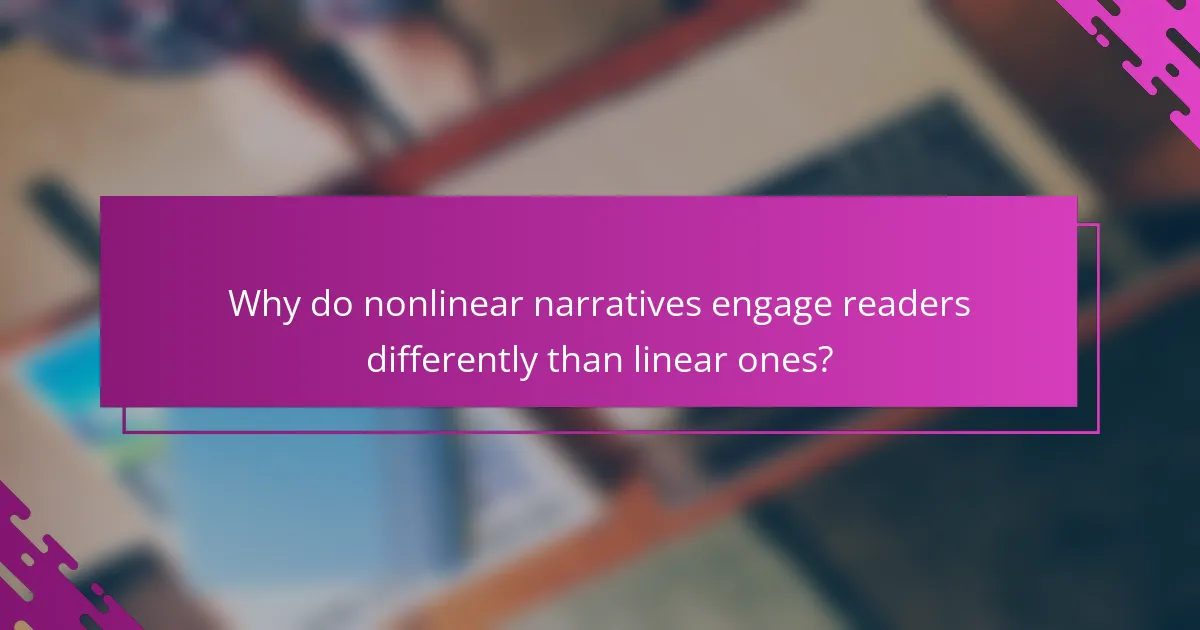
Why do nonlinear narratives engage readers differently than linear ones?
Nonlinear narratives engage readers differently because they create active participation and emotional investment. Unlike linear stories, nonlinear structures allow for multiple perspectives and varied timelines, enhancing intrigue. This complexity encourages readers to piece together the narrative, fostering deeper connections and critical thinking. Unique attributes of nonlinear narratives include their ability to evoke curiosity and challenge traditional storytelling norms. Examples such as “Pulp Fiction” and “The Sound and the Fury” illustrate how this engagement style captivates audiences through unexpected twists and layered meanings.
What psychological effects do nonlinear narratives have on the audience?
Nonlinear narratives can evoke a range of psychological effects on the audience, enhancing engagement and emotional investment. These narratives often create curiosity and challenge traditional storytelling, leading to deeper cognitive processing. As a result, audiences may experience heightened suspense, increased empathy for characters, and a more active role in interpreting the story.
How does reader agency influence engagement in nonlinear narratives?
Reader agency significantly enhances engagement in nonlinear narratives by allowing individuals to shape their own experiences. This interactive element fosters deeper emotional connections and personal investment in the story. Readers navigate through various paths, making choices that influence plot outcomes, leading to a more immersive experience. Consequently, the unique structure of nonlinear narratives cultivates a sense of ownership and active participation, increasing overall satisfaction and engagement.
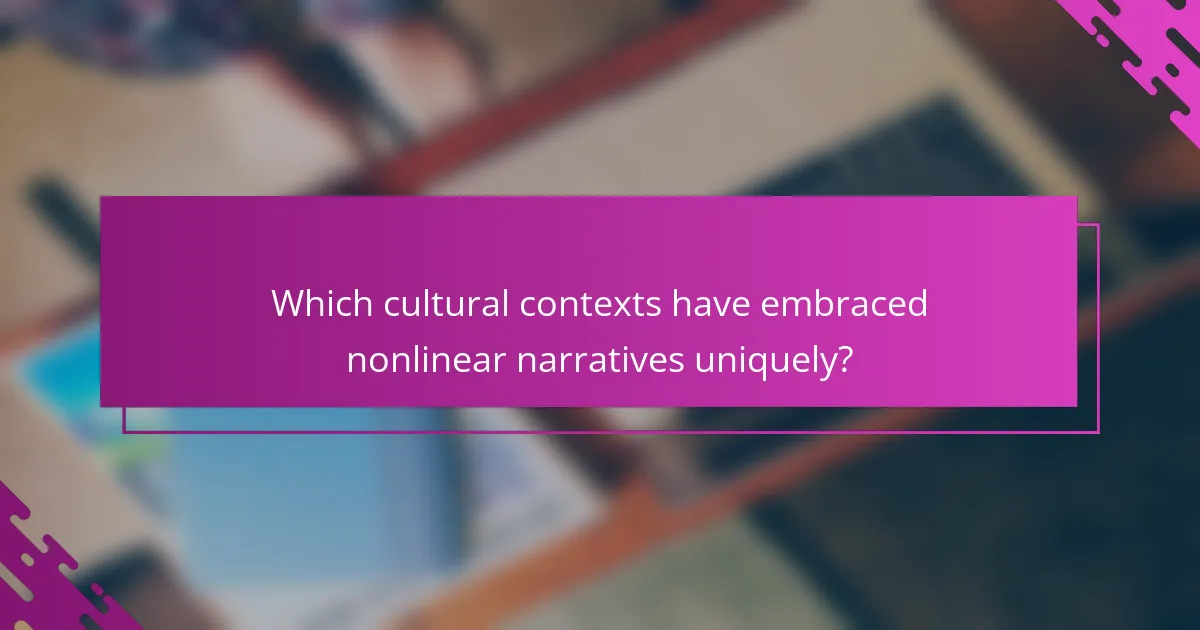
Which cultural contexts have embraced nonlinear narratives uniquely?
Various cultural contexts have embraced nonlinear narratives uniquely, including postmodern literature, Asian cinema, and indigenous storytelling traditions. Postmodern literature often blurs timelines and perspectives, as seen in works by authors like Thomas Pynchon. Asian cinema, particularly in films from directors like Akira Kurosawa, employs nonlinear storytelling to enhance thematic depth. Indigenous storytelling traditions utilize nonlinear narratives to convey cultural heritage and communal experiences, emphasizing the interconnectedness of events. These approaches engage readers and viewers by challenging conventional narrative structures, fostering deeper emotional connections.
How do different regions interpret nonlinear storytelling conventions?
Different regions interpret nonlinear storytelling conventions through cultural lenses, impacting narrative structure and audience engagement. For instance, Western narratives often embrace fragmented timelines, while Eastern traditions may prioritize cyclical storytelling. This diversity enriches reader experiences and offers unique insights into cultural values and perspectives.
What are some cultural events or movements that have promoted nonlinear narratives?
Cultural events and movements that have promoted nonlinear narratives include postmodern literature, experimental theater, and interactive art installations. These forms often disrupt traditional storytelling, engaging audiences in unique ways.
Postmodern literature, exemplified by authors like Thomas Pynchon and Don DeLillo, uses fragmented structures to reflect complexity in modern life. Experimental theater, such as works by the Wooster Group, challenges linear progression, immersing viewers in a multi-layered experience. Interactive art installations, like those by Yayoi Kusama, invite audience participation, creating a nonlinear exploration of themes.
These movements enhance reader and viewer engagement by encouraging active participation and personal interpretation. Nonlinear narratives resonate with contemporary experiences, making them relevant and impactful.
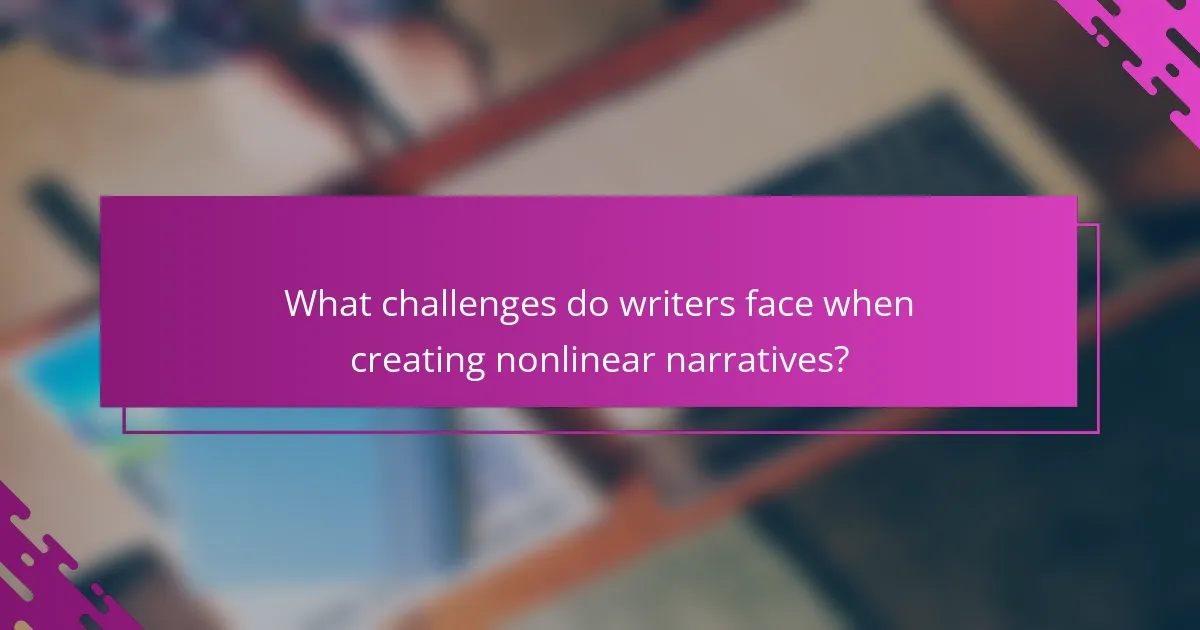
What challenges do writers face when creating nonlinear narratives?
Writers face several challenges when creating nonlinear narratives, including maintaining coherence and ensuring reader engagement. Nonlinear structures can confuse readers if transitions between timelines or perspectives are unclear. Additionally, writers must balance complexity with accessibility to avoid overwhelming the audience. Crafting a satisfying resolution becomes more difficult as plot threads intertwine. Lastly, the risk of alienating readers who prefer traditional storytelling can impact the narrative’s reception.
How can complexity in structure confuse readers and affect comprehension?
Complexity in structure can confuse readers and hinder comprehension by disrupting narrative flow. Nonlinear narratives often present events out of chronological order, which can challenge readers’ ability to follow the plot. This disorientation may lead to frustration and disengagement. For instance, when a story jumps between timelines, readers might struggle to connect character motivations and plot developments. As a result, clarity is sacrificed, impacting overall engagement and retention of information.
What common pitfalls should authors avoid in nonlinear storytelling?
Authors should avoid confusing timelines, excessive complexity, and unclear character motivations in nonlinear storytelling. These pitfalls can alienate readers and disrupt engagement. Maintaining clarity and coherence is essential for effective narrative flow. Additionally, balancing the nonlinear structure with emotional resonance enhances reader connection.

What future trends are emerging in nonlinear narrative design?
Emerging trends in nonlinear narrative design include interactive storytelling, branching paths, and immersive experiences. These trends enhance reader engagement by allowing personalized journeys through narratives.
1. Interactive storytelling: Readers influence story outcomes, increasing emotional investment.
2. Branching paths: Multiple plotlines offer varied experiences, catering to diverse audience preferences.
3. Immersive experiences: Virtual and augmented reality technologies create deeper connections to narratives.
4. AI integration: Algorithms tailor stories based on user behavior, enhancing personalization.
5. Community-driven narratives: Readers contribute content, fostering a sense of ownership and collaboration.
How are technology and digital platforms shaping nonlinear narratives?
Technology and digital platforms are revolutionizing nonlinear narratives by enhancing interactivity and engagement. They allow readers to choose their paths, creating personalized experiences.
Digital platforms, such as video games and interactive storytelling apps, enable users to influence narrative outcomes. This interactivity fosters deeper emotional connections and investment in the story.
Examples include “Bandersnatch,” an interactive film where viewers make choices that affect the plot. Such formats challenge traditional storytelling, encouraging exploration and multiple interpretations.
The impact on reader engagement is significant; nonlinear narratives can lead to increased immersion and retention. As technology evolves, the potential for innovative storytelling continues to expand.
What impact do audience preferences have on the evolution of nonlinear storytelling?
Audience preferences significantly shape nonlinear storytelling by driving innovation and engagement strategies. As readers seek unique experiences, creators adapt narratives to include multiple perspectives and timelines. This evolution enhances emotional connections and encourages active participation, leading to increased reader investment in the story. The unique attribute of nonlinear narratives lies in their ability to cater to diverse audience tastes, fostering a richer storytelling landscape.
What are best practices for crafting compelling nonlinear narratives?
To craft compelling nonlinear narratives, utilize various techniques that enhance engagement. Focus on character-driven plots, fragmented timelines, and multiple perspectives. Incorporate immersive settings to draw readers in and use thematic motifs to create resonance. Balancing complexity with clarity is essential, ensuring that readers remain invested despite the narrative’s nontraditional structure.
